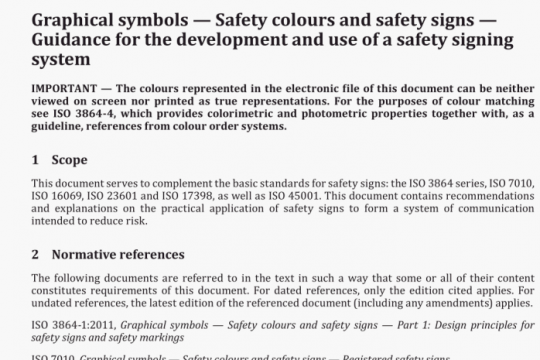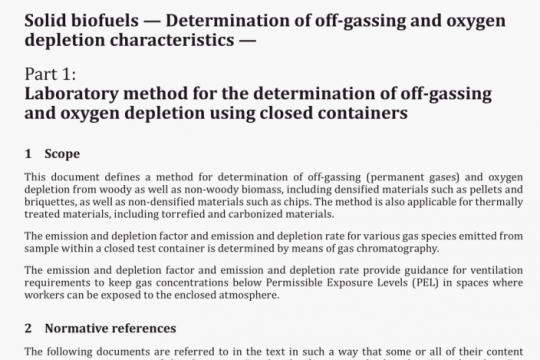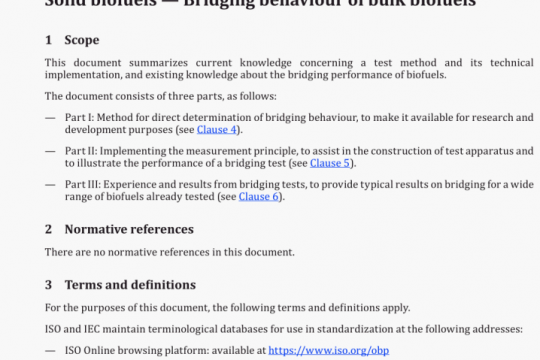ISO 3452-1 pdf free download
ISO 3452-1-2021 pdf free download.Non-destructive testing — Penetrant testing — Part 1: General principles.
7.3.4 In situations where contamination can occur, it is essential to ensure that the penetrant testing products do not have a deleterious effect on fuels, lubricants, hydraulic fluids, etc.
7.3.5 For parts associated with peroxide rocket fuel, explosive stores (these include all items containing explosive propellant, initiating or pyrotechnic materials), oxygen equipment or nuclear applications, the compatibility of penetrant testing products shall be given special consideration.
8 Test procedure
8.1 Written test procedure
All testing shall be performed in accordance with an approved written documentation, either specifically prepared or included in the relevant product standard. The written test procedure shall also include all relevant parameters for testing, e.g. temperatures, times, pressures. When generating test procedures, the product manufacturer’s recommendations shall be taken into account.
8.2 Precleaning
8.2.1 General
Contaminants such as scale, rust, oil, grease, paint and water shall be removed — if necessary using mechanical or chemical methods, or a combination of these. Precleaning shall ensure that the test surface is free from residues and that it allows the penetrant to enter any discontinuity. The cleaned area shall be large enough to prevent interference from areas adjacent to the actual test surface.
8.2.2 Mechanical precleaning
Scale, slag, rust, etc. shall be removed using suitable methods such as brushing, rubbing, abrasion, blasting or high-pressure blasting (water or ice pellets). These methods remove contaminants from the surface and generally are incapable of removing contaminants from within surface discontinuities. In all cases care shall be taken to ensure that the discontinuities are not masked by plastic deformation or clogging from abrasive materials. If necessary to ensure that discontinuities are open to the surface, subsequent etching treatment shall be carried out, followed by adequate rinsing and drying.
8.2.3 Chemical precleaning
Chemical precleaning shall be carried out, using suitable chemical cleaning agents, to remove residues such as grease, oil, paint or etching materials.
Residues from chemical precleaning processes can react with a penetrant and greatly reduce its sensitivity. Therefore, chemical agents shall be removed from the surface under examination, after the cleaning process, using suitable cleaning methods.
8.2.4 Drying
As the final stage of precleaning, the parts to be tested shall be thoroughly dried, so that neither water nor solvent remains on the test surface and in the discontinuities.
83 Temperature
The testing materials, the test surface and the ambient temperature shall be within the range from 10 °C to 50°C, except for the drying process (4). Rapid temperature changes can cause condensation, which may interfere with the process and should be avoided.
For temperatures outside the range from 10 °C to 50 °C, inspection shall be carried out in accordance with ISO 3452-5 or ISO 3452-6, as applicable.
8.4 Application of penetrant
8.4.1 Methods of application
Penetrant can be applied to the part to be tested by spraying, brushing, flooding, dipping or immersion.
Penetrant shall remain on the test surface throughout the entire penetration time.
8.4.2 Penetration time
The appropriate penetration time depends on the properties of the penetrant, the application temperature, the material of the part to be tested and the discontinuities to be detected.
The penetration time shall be between 5 mm and 60 mm and shall not be less than the manufacturer’s recommended time for the required sensitivity. The penetration time shall be defined in the written test procedure.
8.5 Excess penetrant removal
8.5.1 General
The excess penetrant removal shall be such that penetrant remains in the discontinuities.
8.5.2 Water
When water is used for removal it shall be applied by wiping, immersion or spray. Care shall be exercised to avoid overwashing for example by the use of high-pressure spray, excessive time or excessive mechanical action. When wiping is used, excess penetrant shall be removed first by using a suitable clean lint-free cloth or absorbent paper and subsequently by cleaning with a clean lint-free cloth lightly moistened with water.
8.5.3 Solvents
Excess penetrant shall be removed first by using a suitable clean lint-free cloth or absorbent paper and subsequently by using a clean lint-free cloth lightly moistened with solvent. Any other removal technique shall be technically approved for adequacy and agreed by the contracting parties, particularly when the solvent remover is sprayed directly onto the part to be tested.
8.5.4 Emulsifier
8.5.4.1 Hydrophilic (water-dilutable)
To allow the post-emulsifiable penetrant to be removed from the test surface, it shall be rendered waterrinsable by application of an emulsifier. Before the application of the emulsifier, a water wash shall be performed in order to remove the bulk of the excess penetrant from the test surface and facilitate a uniform action of the hydrophilic emulsifier that will be applied subsequently.ISO 3452-1 pdf download.




